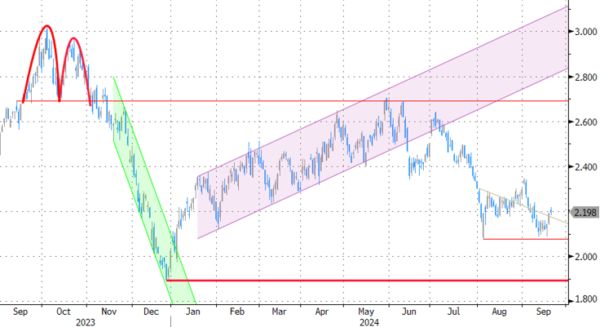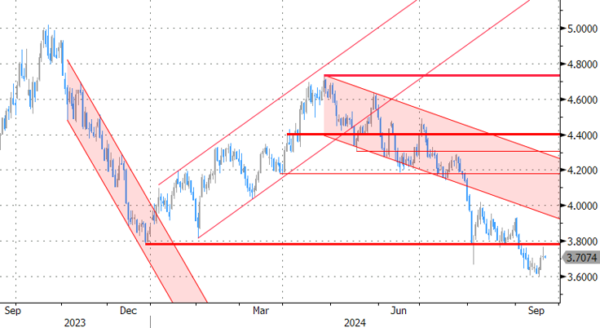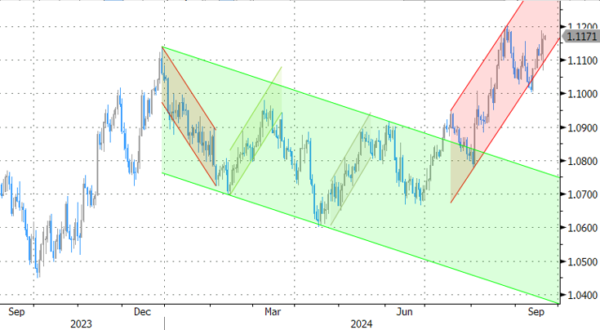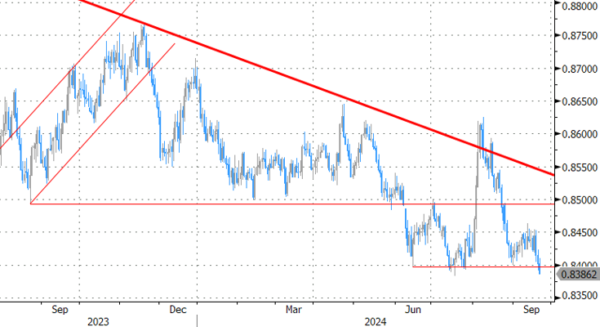Markets
Wednesday’s bumper 50 bps Fed kick-off yesterday resulted in a further steeping of the US curve, with the short end still challenging recent lows. The intraday price dynamics was briefly interrupted by a better than expected Philly Fed business outlook and even more by a decline in the weekly jobless claims (219k from 231k). This supports Powell’s view that the Fed isn’t behind the curve and that it is supporting the economy/the labour market while it is still strong, helping to engineer a soft landing of the US economy. Even so, markets soon resumed their intraday pattern. US yields changed between -3.6 bps (2-y) and +3.0 bps (30-y). The US 2-y yield is only a whisker away from the March 2023 low (3.55% area). The rise in LT yields was mainly driven by a rebound in inflation expectations (10-y + 5.0 bps). The 10-y real yield declined 5.0 bps. This idea of a soft landing/mild reflation further propelled equities with the Dow and the S&P closing at new record levels. Reflationary hopes, amongst others, also supported a further rebound in the oil price (Brent $74.5 p/b). German yields traded in sympathy with the US (2-y -4.2 bps, 30-y +4.5 bps). US curve steepening and an outright risk-on context kept the dollar in the defensive, especially against the likes of the euro or currencies sensitive to the overall economic cycle (AUD, NZD…). EUR/USD closed at 1.1162, with the august top (1.1202) within reach. USD/JPY gained mostly (142.6 from 142.3) on yen underperformance. The eco calendar in the US and EMU is almost empty. We expect technical trading going into the weekend. The steepening trend might continue as markets can still raise the odds for follow-up 50 bps steps from the Fed in November and December. However, such a push needs more soft data, which we won’t get today. The dollar still remains at risk to fall below key support levels (EUR/USD 1.1202/1.1276, DYX 100.55/99.58).
This morning, UK data printed mixed. GfK consumer confidence unexpectedly tumbled from -13 to -20. Consumers turned more pessimistic both on their personal situation as on the global economic outlook. UK August retail sales printed at a much stronger than expected 1.0% M/M and 2.5% Y/Y. Yesterday, the BoE let its policy rate unchanged at 5.0% after an inaugural step in August as it wants to take a cautious approach as core/services inflation remains elevated. After the retail sales release, EUR/GBP is heading for a test of the YTD lows (0.8383 area).
News & Views
The Bank of Japan kept the policy rate unchanged at 0.25%. The status quo was widely expected after a previous hike rattled markets end July/beginning of August. Language at that time signalling further hikes if the July outlook would materialize, didn’t make it in the statement this morning. Still, the BoJ upgraded its assessment of private consumption from “being resilient” to “being on a moderate increasing trend” thanks to a virtuous cycle from income to spending. Along with improving exports and against a background of accommodative financial conditions that should help Japan’s economy grow at a pace above potential. Inflation, both headline and underlying, are seen evolving according to the July outlook. The gauges are still seen to be consistent with the 2% target somewhere in the second half of the projection period. Inflation figures printed as fresh as this morning and ahead of the policy meeting outcome showed prices rose at a quicker pace in August. Headline CPI rose from 2.8% to 3% while the core measure (ex. fresh food and energy) fastened from 1.9% to 2%. The BoJ’s preferred gauge (ex. fresh food) picked up from 2.7% to 2.8%. The market reaction was a dull one with some minor JPY appreciation to USD/JPY 142.33.
Chinese bank kept their benchmark lending rates unchanged at 3.35% (1-yr) and 3.85% (5-yr). They lowered last time in July after the Chinese central bank cut its 7-day reverse repo rate back in July by 10 bps to 1.7%. There have been no cuts since, but the PBOC last week in an unusually explicit statement said that they are “preparing to launch some additional measures, further lower the financing costs for businesses and households, and keep liquidity reasonably ample.” after another string of weak data and as the housing market meltdown continues. Regarding the latter, Bloomberg reports China is considering to remove some of the largest remaining restrictions (targeting non-local buyers) on home purchases in a new attempt to revive the market. A slew of earlier measures have failed to do so. The Chinese yuan is giving it the benefit of the doubt though we suspect some technical considerations push the currency higher too. USD/CNY dropped below 7.05 for the first time since May 2023.
Graphs
GE 10y yield
The ECB cut policy rates by 25 bps in June and in September. Stubborn inflation (core, services) make follow-up moves less evident. We expect the central bank to stick with the quarterly reduction pace. Disappointing US and unconvincing EMU activity data dragged the long end of the curve down. The move accelerated during the early August market meltdown.
US 10y yield
The Fed kicked off its easing cycle with a 50 bps move. It is headed towards a neutral stance now that inflation and employment risks are in balance. Conservative SEP unemployment forecasts risk being caught up by reality and with it the dot plot (50 bps more cuts in 2024). We hold our call for two more 50 bps cuts this year. Pressure on the front of the curve and weakening eco data keeps the long end in the defensive for now as well.
EUR/USD
EUR/USD moved above the 1.09 resistance area as the dollar lost interest rate support at stealth pace. US recession risks and bets on fast and large rate cuts trumped traditional safe haven flows into USD. EUR/USD 1.1276 (2023 top) serves as next technical references.
EUR/GBP
The BoE delivered a hawkish cut in August. Policy restrictiveness will be further unwound gradually on a pace determined by a broad range of data. The strategy similar to the ECB’s balances out EUR/GBP in a monetary perspective. Recent better UK activity data and a cautious assessment of BoE’s Bailey at Jackson Hole are pushing EUR/GBP lower in the 0.84/0.086 range.
















